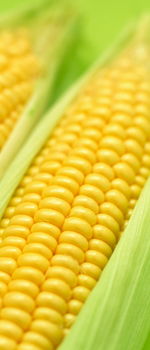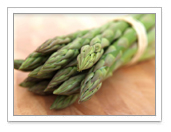
|
Follow Me On: |
 |
Brent Prockish Brent Prockish Team at Total Lending Concepts Phone: 913-444-9194 License: 229476 Brent@TLCLender.com www.BrentProckish.com |
 | ||
| ||||
March 2012

|
Spring Veggies A Minimalist's Approach to One of Life's Simple Pleasures By Kirk Leins
The onset of spring brings a slew of accompanying pleasures. Some of these pleasures, the best of them really, also happen to be the most simple--beautiful weather and the start of the baseball season, just to name two. But for me, there's one simple pleasure surrounding spring that outshines the rest. Believe it or not, I'm talking about vegetables. It may sound farfetched but, before you disagree, allow me to present my case. A Long, Cold Winter Winter veggies also tend to be inexpensive, and it's primarily due to their lower ranking on the vegetable totem pole. Despite their eventual deliciousness, they usually require additional labor in order to bring out their best. Whether you're peeling or grating, chopping or mashing, few winter veggies are eaten as is, let alone raw. The extra labor and longer cooking times associated with winter vegetables seem to have pigeonholed their use within the culinary world. They repeatedly pop up in the same types of dishes, with soups and stews being the most common. Meals such as these tend to cook longer, as do their vegetable components. But that changes when springtime arrives. Spring Has Sprung Regarding their preparation, many spring veggies can actually be served raw. At the same time, I believe the best recipes for said veggies are typically basic ones, utilizing minimal cooking times and ingredients. This should make any weekday meal preparers out there extremely happy. So here's the plan. I'm using the remainder of this article to focus on a few of my favorite spring veggies. I'll not only tell you what to look for when buying these vegetables, but I'll also give you a minimalist, yet delicious preparation suggestion for each. Here we go. ARTICHOKES Although it's not one of the "prettier" spring vegetables, the artichoke may be one of the tastiest. The following is one of my absolute favorite artichoke preparations. Grilled Artichokes with Easy Aioli Dipping Sauce (serves 2 to 4)
For the Dipping Sauce:
Using kitchen shears, cut the pointed ends off of all the artichoke's leaves. Using a pairing knife, peal the rough outer skin from the artichoke's stem. Add a handful of Kosher salt and both lemon halves to the pot of boiling water. Boil artichokes for roughly 20 minutes or until you are just able to pull out the leaves. Remove artichokes from pot, allowing them to cool completely while draining upside down. Meanwhile, in a mixing bowl combine all the ingredients for the dipping sauce and store in the refrigerator. Once the artichokes have cooled, split them in half lengthwise, using a sharp knife. Then, using either a spoon or a pairing knife, scrape out the fibrous choke. Lightly brush the cut sides with olive oil, and season with salt and pepper. Heat either a grill or a grill pan until quite hot. Place artichokes cut-side down and grill until evenly charred. Turn artichokes over and grill for a few additional minutes. Serve with dipping sauce. It's important to note that since we removed the choke, the entire artichoke heart and stem are edible. ASPARAGUS One of my favorite ways to prepare asparagus is to roast it in the oven. I guarantee you're going to love it. Oven-Roasted Asparagus (serves 2 to 4) Place asparagus in the oven and roast for 10 minutes. Remove asparagus from the oven and toss again. Return to the oven and roast for an additional 8 to 10 minutes or until the tips are slightly charred and the asparagus is cooked through. Serve. SWEET CORN When choosing corn, look for bright green husks with silks that are light in color and moist but not soggy. When pressing on the husks, you should be able to feel firm, individual kernels. From boiling and steaming to grilling and roasting, there are many methods for cooking corn. No matter which one I utilize, I have two steadfast rules. First, whenever possible I buy my corn on the day I intend to cook it. As soon as corn is picked from the stalk, it begins converting its sugars to starch. Ergo, the fresher the corn, the sweeter it's going to be. Farmers' markets and roadside vegetable stands in rural areas are typically reliable for selling freshly-picked corn. Rule number two has to do with cooking time. Regardless of what cooking method I'm using, the goal is to cook the corn for as short a time as possible. Overcooking corn will transform the corn's delicate sugars into gummy starch. Once you've had perfectly cooked sweet corn, you will never go back. One of my favorite methods of cooking corn is boiling it on the cob. It's quick, easy, and yields some of the truest corn flavor you will ever taste. Here's my method: Boiled Corn on the Cob ENGLISH PEAS Green peas are a vegetable with many uses, but when it comes to sweet spring peas, there may be no better preparation than a simple blanching. This method brings out their true sweetness without stepping on the overall flavor. The best part is it couldn't be simpler. Here is the method utilized by one of my heroes, the late chef, Julia Child. Julia Child's Green Peas (serves 6)
Place shelled peas and the remaining ingredients in a 3-quart saucepan. Using your hands, massage the butter and seasonings into the peas until all are well-coated. Add just enough cold water to the saucepan to reach the top of the peas. Cover, bring to a boil, and reduce to a simmer. Simmer peas for 6 minutes. Lift lid and check peas for doneness and seasoning. Add a touch more salt or sugar if necessary. If water has boiled off and peas are not quite tender, add a touch more water and continue to simmer. If peas are tender but the water hasn't boiled off, uncover and simmer until only a teaspoon or so of liquid remains. Serve. So, there you have it; four of my favorite spring vegetables, and four simple preparations designed to bring out the true flavor of each. I can hardly wait until next month when I share with you some great recipes for spring fruits.
| ||||||||||||||||||||||||||||||||
Total Lending Concepts NMLS #1043976 (Corporate) #2348348 (KS Branch) 6900 College Blvd., Suite 800, Overland Park, KS, 66211 (KS Office) 219 E Broadway, Columbia, MO. 65203 (MO Office) You are receiving a complimentary subscription to YOU Magazine as a result of your ongoing business relationship with Brent Prockish. While beneficial to a wide audience, this information is also commercial in nature and it may contain advertising materials. INVITE A FRIEND to receive YOU Magazine. Please feel free to invite your friends and colleagues to subscribe. SUBSCRIBE to YOU Magazine. If you received this message from a friend, you can subscribe online. UNSUBSCRIBE: If you would like to stop receiving emails from Brent Prockish, you can easily unsubscribe. Brent Prockish Team at Total Lending Concepts |
6900 College Blvd., Suite 800 Overland Park, KS 66211 Powered by Platinum Marketing © Copyright 2024. Vantage Production, LLC. | |||||||||



